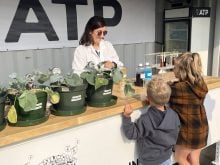Western Canadian farmers could find themselves at war with Hessians this year.
Not the 18th century German soldiers hired by the British to fight in the American Revolution, but hessian flies, a pest that can take a bite out of a farmer’s late-seeded wheat crop.
The oddly named fly is native to Asia but was transported into Europe and later into North America, supposedly in the straw bedding of Hessian troops.
Hessian flies, which are from the same family of insects as the wheat midge, can show up anywhere in the Prairies and are usually associated with late-seeded wheat, said Ian Wise, an entomologist at the Cereal Research Centre in Winnipeg.
Read Also

Field-by-field mapping could improve yield, productivity predictions
University of Saskatchewan researchers are using field border mapping to collect data on field variability, including problematic weeds, and to predict things like yields.
Damage from the three to five millimetre long black midge-type fly is limited most years.
However, conditions could be right for hessian flies in certain areas this year because of the seeding problems experienced by many producers.
“We certainly could see more damage this year if there is a significant amount of late-seeded wheat going into the ground,” Wise said.
Another problem with the hessian fly is there are no control products available for spring wheat.
An Agriculture Canada publication says Disulfoton can be used on winter wheat, but the best methods are crop rotation, early seeding and resistant varieties such as Superb and Waskada. Unfortunately, it’s too late for any of those measures this year.
“This year it could be a big problem,” Wise said.
Hessian fly larvae feed on the plant at the point where the leaf blade meets the stem. This weakens the stem, predisposing it to breakage and yield loss.
It has two generations a year.
In winter wheat, fall rain triggers the emergence of flies, which lay eggs and establish the new generation that causes feeding damage to seedlings. A second generation emerges the following spring.
The economic impact of hessian flies has not been well documented. Manitoba crop watchers estimate yield loss from broken stems as high as 10 to 20 percent in some years.
Wise said researchers periodically have success screening for hessian fly resistance and have looked into the possibility of incorporating resistant genes from winter wheat by backcrossing them directly into spring wheat.
Experimental lines have been developed, but Wise said they are a long way from registration.
The hessian fly is a much bigger issue in the United States and researchers have been working hard to develop resistant winter wheat varieties.
A recent news release from Purdue University in Indiana identified the method by which resistant varieties fight off the fly.
A resistant plant under attack will increase production of surface waxes and cutin, a molecule responsibility for the rigidity and integrity of epidermal cells.
The genes are turned off in susceptible plants, likely by the attacking larvae.
“If we could find a way to block the larvae from affecting genes that are responsible for cutin production or a way to keep that cutin from degrading, the plants might be more resistant,” said entomologist Christie Williams of the U.S. Department of Agriculture and Purdue.
Sinapis arvensis or charlock mustard, also known as wild mustard, is an aggressive weed that has kept many growers from exploring tame mustard production.
The weed can be found in most grain growing regions of the northern hemisphere and shows up as far north as the MacKenzie region of the Northwest Territories.
It’s a spring annual and, when growing in soil containing clubroot spores, can both activate the spores and become infected by the disease.
The plant can grow from 10 to 100 centimetres in height. It has branches and leaves that are hairy, unevenly toothed and end in a rounded lobe.
Branches at the base often have violet spots. The stem hairs are stiff and pointed toward the ground.
Seeds begin germination at 2 to 4 C and will continue with rain and rising soil temperatures. Seeds prefer to start shallow in the soil, but can hang around for up to 10 years waiting for a chance to grow.
Seeds can survive through animal feeding, so hay from fields or pastures where the mature plant is present can end up spreading the weed with the manure.
The weed has broad, kidney shaped, cotyledon leaves. Its yellow flowers can be mistaken for other mustard family plants. The seedpods are also known as siliques.
As a podded plant, it differs from other mustards by having seeds in the flat terminal end of the seedpod. The pods narrow toward the last third of their terminal end and are held to the plant by a short, thick piece of stalk at the other end.
In canola, the upper leaves don’t have their own stalks, while the wild mustard plants have a short stalk.
The plant acts as host to a variety of disease causing organisms that can damage other brassicas such as canola. In a canola or mustard crop, wild mustard is highly undesirable. If allowed to contaminate the cropped seed, it can reach levels where the canola will be graded sample, resulting in big financial losses.
The tolerance for the weed is about 20 plants per sq. metre in a canola crop before the plant will generate five percent of the seed harvested and a sample grade.
In cereals, 10 plants in 0.1 metre, or a sq. foot, can result in a 10 to 20 bushel per acre yield loss. For flax growers, 10 in a sq. metre can cut yields up to 50 percent, with 33 plants in that same space reducing yields by 65 percent in a pea crop.
Herbicide tolerant canola varieties and hybrids have helped reduce the weed’s presence in those fields.
The plants have little or no resistance to tillage. However, tillage can also disturb ungerminated seeds creating other issues related to moisture loss, erosion and increased production costs.
The good news is that herbicides are available to control the weed both in a pre-seed burn off and in-crop situations. The only control challenges are in other non-herbicide resistant brassica crops and when the weed stage is well advanced.
Some wild mustard has developed tolerance to Group 2, ALS inhibitor herbicides, including ethametsulfuron-methyl, imazethapyr, thifensulfuron-methyl and tribenuronmethyl.
Multiple herbicide approaches, crop rotation and limiting seed production are the most effective control methods.
The brassica is effective at using both moisture and nutrients early in the season, robbing a desired crop of inputs and water, so early control is critical.
















